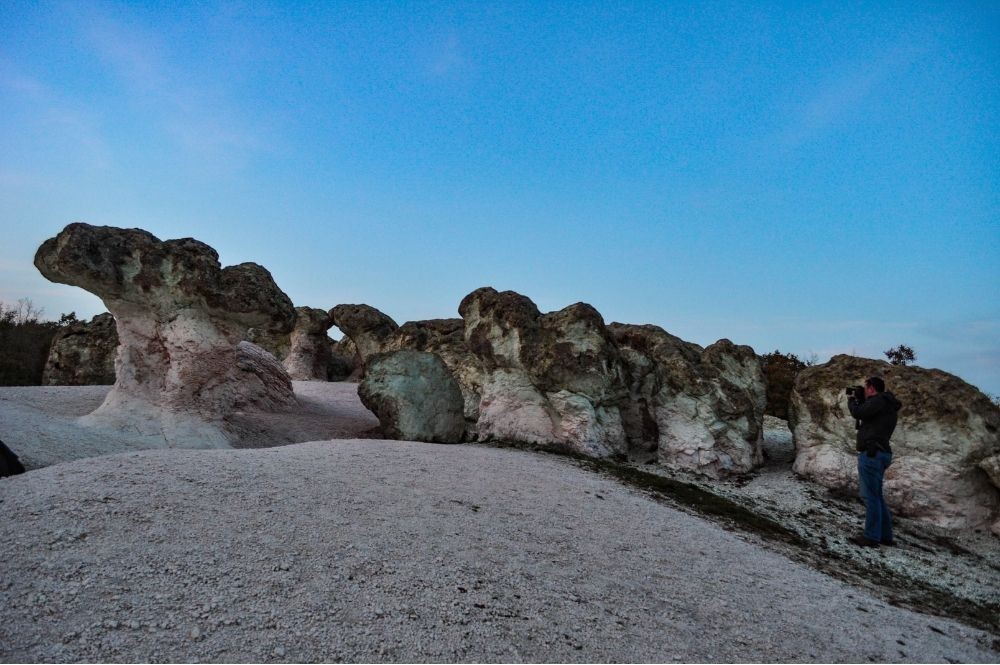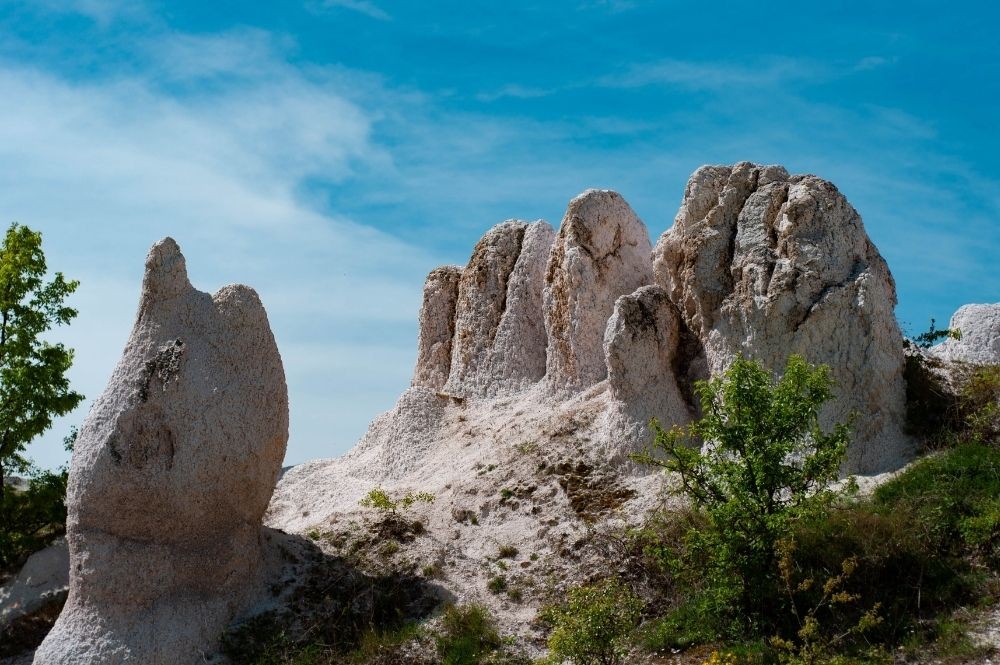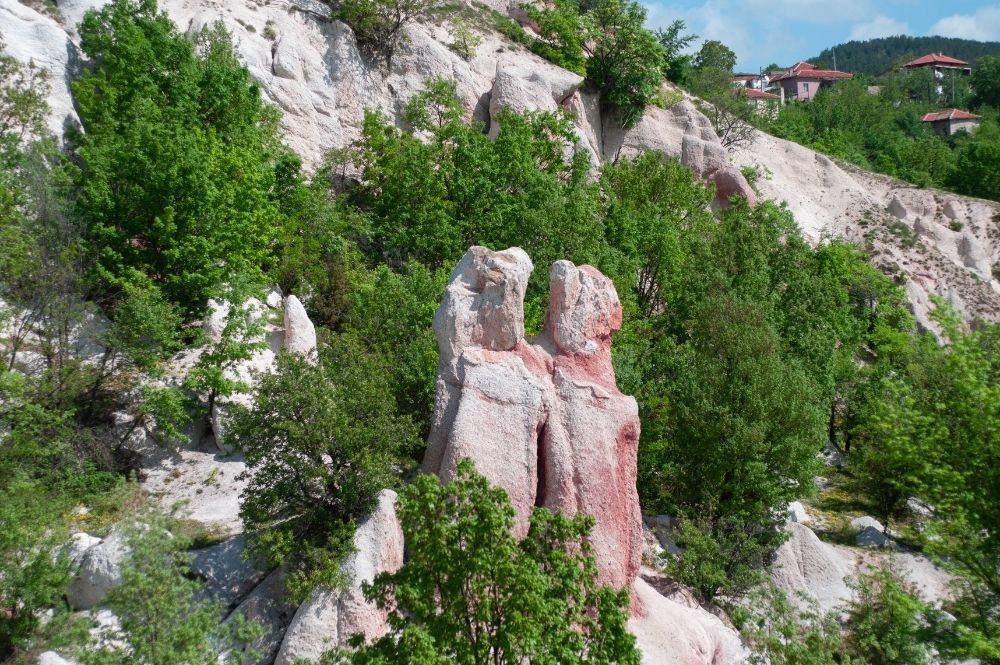Ancient megaliths hidden in the folds of the mountain, Thracian sanctuaries, old stone bridges and rock formations – all that looks more like an alien landscape, than a place on Earth, Bulgaria, The Eastern Rhodopes. The stone figures in the vicinity of the town of Kardzhali capture the imagination of both locals and visitors to that mythical land shrouded in legend.
Billions of years ago this place was the bottom of an ocean. Robust underwater volcanic eruptions of ashes settled down and formed thick layers. The explosions melted together ashes and fragments of crumbling coastal rocks, thus creating the most curious tuff figures. Later on these formations were further sculptured by the gushes of wind and sand until they turned into the frozen fantastic figures of today.
The stone mushrooms near the village of Beli Plast
If you happen to travel from Kardzhali to Haskovo near the village of Beli Plast to the left of the road there is a small hill, crowned by a very bizarre composition of nature-made sculptures.
These are the stone mushrooms - one of the biggest attractions in the area. They are up to 2.5 m high, and their caps are more or less as wide. The stems are brittle and prone to erosion while the caps are tough because they contain the so-called volcanic glass. Depending on the light, the shades of tufted mushrooms range from pink and greenish to dazzling white. They were declared a natural landmark more than 4 decades ago, and the protected area is home to some rare birds - canaries, Egyptian vultures, etc.

The area of the Stone Mushrooms is not guarded, and as a result tourists often climb the frangible rock formations to take selfies against the background of the nearby Rhodope heights.
Like most rock formations scattered around the Rhodopes, the Stone Mushrooms have a legend.
The legend of the brave daughters of Raduil
Ledgend has it that the mushrooms are the petrified heads of the four daughters of the charcoal burner Raduil. One morning as they went to the river to bring water, a great horde of robbers started chasing them. The girls managed to frighten the horse of the robbers’ leader, and he fell off the horse. The four sisters killed him, then ran to a nearby forest.
But one of the villains caught up with them. He lashed out with his yataghan and cut off the first girl’s head. As it fell on the ground, it turned into a stone mushroom. The same happened with the other sisters. The terrified man tried to escape with his horse, but turned into a black rock at the first step. To this day, people call the lone jagged rock near the mushrooms Karatepe(black hill).
The Stone Wedding near Zemzelen village

Along the road to the village of Zemzelen in Kardzhali region, one will come across a fantastic natural stone formation. The figures are spread over 40 acres taking the shapes of people, animals, and plants. The minerals in these rocks give them their colors of white, yellow, pink, green, rust red, the shades of which also change with the daylight.
And the most impressive are the two 10-meter figures, reminiscent of a man and a woman embracing. The locals called them the Stone Wedding and to this day they tell a legend.
A legend of sin and divine retribution
According to the legend, at a wedding procession by the village of Zemzelen, a strong wind blew off the veil of the bride. Her indescribable beauty made the guests speechless, and the father-in-law felt jealous of his son. The natural forces petrified everyone for the impure thoughts of the father-in-law. Only the groom remained, numb with grief and terror, begging the wind to petrify him too. The wind fulfilled his request.

At the boy's feet there still is puddle, which is believed to be formed by the tears of the unfortunate groom.
Author: Veneta Nikolova
Photo credit: Veneta Nikolova
English version: Elizabeth Radkova
An exhibition showcasing iconic cultural and natural tourist sites from Bulgaria has been opened in front of the Bulgarian Embassy in Stockholm. "Bulgaria is a country with an impressive history, rich cultural and historical heritage and..
The winter resort of Pamporovo in the Rhodope Mountain is crowded. We are experiencing a strong season and an increase in tourists from Romania, Greece and Serbia. This was told to BTA by Dimitar Gerdzhikov from Pamporovo AD. Gerdzhikov added..
Eight thousand years ago, one of the most mysterious cultures in the Balkans emerged in the area of the present-day village of Dolnoslav. In the area of Asenovgrad , between the plain and the mountains, archaeologists uncover settlement mounds..
An exhibition showcasing iconic cultural and natural tourist sites from Bulgaria has been opened in front of the Bulgarian Embassy in Stockholm...

+359 2 9336 661
